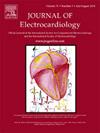Fentanyl-induced Brugada phenocopy: A case report
IF 1.2
4区 医学
Q3 CARDIAC & CARDIOVASCULAR SYSTEMS
引用次数: 0
Abstract
Brugada Syndrome (BrS) is a genetic condition characterized by specific electrocardiographic (ECG) findings and an increased risk of life-threatening arrhythmias. Brugada phenocopy (BrP) refers to reversible ECG changes mimicking BrS caused by external factors, such as drugs or metabolic disturbances. Here, we present a case of a 45-year-old male with Brugada phenocopy due to high-dose of fentanyl transdermal patch.
芬太尼致Brugada表型1例报告
Brugada综合征(BrS)是一种遗传性疾病,其特征是特定的心电图(ECG)表现和危及生命的心律失常的风险增加。Brugada phenoopy (BrP)是指由药物或代谢紊乱等外部因素引起的类似BrS的可逆性心电图改变。在此,我们报告一例45岁男性因高剂量芬太尼透皮贴剂而出现Brugada表型。
本文章由计算机程序翻译,如有差异,请以英文原文为准。
求助全文
约1分钟内获得全文
求助全文
来源期刊

Journal of electrocardiology
医学-心血管系统
CiteScore
2.70
自引率
7.70%
发文量
152
审稿时长
38 days
期刊介绍:
The Journal of Electrocardiology is devoted exclusively to clinical and experimental studies of the electrical activities of the heart. It seeks to contribute significantly to the accuracy of diagnosis and prognosis and the effective treatment, prevention, or delay of heart disease. Editorial contents include electrocardiography, vectorcardiography, arrhythmias, membrane action potential, cardiac pacing, monitoring defibrillation, instrumentation, drug effects, and computer applications.
 求助内容:
求助内容: 应助结果提醒方式:
应助结果提醒方式:


